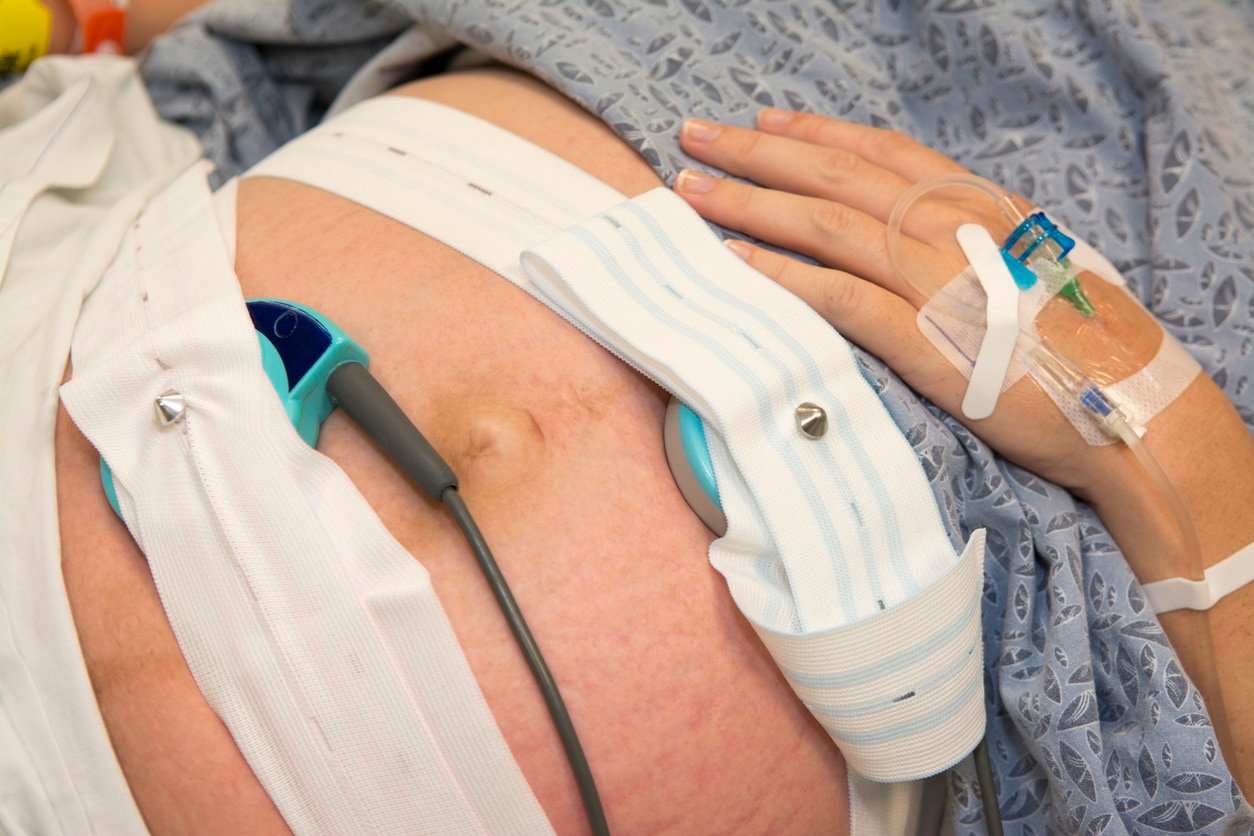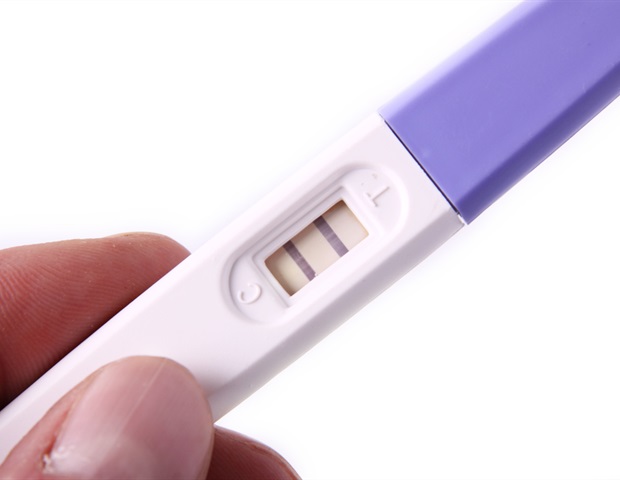There are many interventions to consider when planning your ideal birth, and it is essential to understand common labor, delivery, and postpartum interventions. This way, when your provider or nurse says it is time to place your IV, hep lock, or saline lock, you know the reasons why and your options.
A woman’s medical providers may need direct access to a vein during labor for various reasons, which is what an IV provides. Your head might spin if you have taken a birth class or read some information about IVs during labor. The terminology can get confusing, even for a nurse like myself! Here we will look at a help lock vs. a saline lock vs. IVs and how they directly access your bloodstream.
What is an IV?

The term “IV” is short for “intravenous,” which means “within a vein” and refers to an intravenous line. Doctors or nurses use a needle to insert a soft, flexible, very narrow tube into a peripheral vein, such as in the hand or arm. They then secure the catheter in place and remove the needle. The needle does not remain in your body while the IV is in place.1
What runs through an IV, if anything, can vary. An IV catheter is primed with a saltwater solution before insertion so that no air enters your bloodstream from inside the tubing. If no fluids are constantly running through the IV catheter, it must be locked to keep germs out. Nurses must also flush it with fluid regularly to prevent a clot from forming in the tube.
What is a Hep Lock?

A hep lock, short for a heparin lock, means the IV catheter is flushed with a heparin solution when the IV is not in use. Heparin is a blood thinner medication that helps to prevent blood clots but poses a risk for excessive bleeding. Heparin locks are not used in peripheral IVs because the risk of bleeding outweighs the risk of the line clotting and having to initiate a new IV.
These locks are reserved for central lines. It is more critical that central venous catheter lines do not clot because new IV access is much more difficult to obtain. However, central lines are not standard in labor and delivery units. Heparin locks are not always necessary, so it is vital to avoid them, if possible, especially during labor and delivery because laboring and freshly postpartum women are already at risk for hemorrhage.2
What is a Saline Lock?

Many sources mistakenly refer to a saline lock as a hep lock colloquially, so there is confusion between the two.
A saline lock is a peripheral IV catheter that does not have fluid running through it. Nurses routinely flush it with a standard saline solution (salt water at the same concentration as your blood). If you have an IV in your arm or hand but are not hooked up to tubes and receiving fluids, then you likely have a saline lock.
Saline does not contain medications, but it maintains the IV catheter’s patency when flushed at appropriate intervals with enough volume. Flushing an IV to prevent clotting is essential to avoid losing the line and being stuck again with a new needle for intravenous access.
What Runs Through an IV?
Regardless of what type of IV lock or line you start with, hospital staff can use them to access your bloodstream and administer different products directly and efficiently. Some products they might administer through your IV include:
Fluids
Even if your provider recommends you consume nothing by mouth during your labor, it is crucial to maintain proper hydration and energy to make it through delivery. They can use your IV port to administer a continuous flow of fluids into your bloodstream to replace what you would get from eating and drinking. These fluids may contain things like salt, other electrolytes, and sometimes sugar. Think of IV fluids sort of like Gatorade directly for your blood. Fluids and salts help maintain your blood volume and blood pressure.3
There is some thought that including sugar in your IV fluids during labor may help improve the strength of uterine contractions, therefore decreasing labor time and reducing the rate of C-sections, but studies have not proven this.4
IV fluids can help to maintain blood volume in the event of too much blood loss during labor, delivery, and postpartum. They can also help maintain blood pressure, especially when epidural insertion causes a sudden drop in blood pressure.5
Medications
Doctors also use IV ports to administer medications directly into your bloodstream. These medications can run alongside continuous IV fluids, and some can be given alone with a saline flush to ensure all the medication gets out of the IV tubing and into your bloodstream.
Some common medications given during labor include:
- Oxytocin is a drug often used to induce or augment labor. Doctors may also give oxytocin after delivery to treat postpartum hemorrhage because it causes the uterus to contract and slow the bleeding. IV oxytocin is more effective at preventing postpartum hemorrhage than intramuscular injection of the same medication.6
- Antibiotics are often given during labor to prevent bacterial infection in you and your newborn, mainly if you have tested positive for Group B strep or if your water has been broken for a long time. Doctors also routinely give antibiotics before C-sections to prevent the risk of infection at the incision site.
- Doctors use IV opioid medications in place of or in addition to epidurals to help alleviate labor pains, although they will not eliminate pain. Opioids can cause side effects such as nausea and vomiting, decreased breathing rate, itchiness, drowsiness, constipation, and urinary retention. They can also cause sleepiness in your newborn after delivery.7
Blood Products
A postpartum hemorrhage can occur if a piece of your placenta is retained in your uterus, if lacerations on your cervix or birth canal are bleeding profusely, or if your uterus is not contracting to heal the placental wound. In these cases, it is sometimes necessary to administer blood products to the new mother to prevent maternal morbidity and mortality associated with significant blood loss. Doctors can use your IV to give you these blood products.8
As you can see, there are many reasons to get an IV, whether a saline lock or continuous fluids, during labor. However, IV insertion and use do come with some risks.
What are the Risks of IVs?
The main risks of IV insertion include the following:
- Infection
- Pain
- Clotting
- Inflammation
All of these risks may occur at the insertion site, and they apply even if you get a saline lock with nothing running through it.9
If you have continuous fluids running through your IV during labor, there are other risks and considerations for you and your baby, including:
Newborn Hypoglycemia
If your IV fluids contain sugar or dextrose, there is a slight risk for rebound hypoglycemia or low blood sugar in your newborn after delivery.4
Newborn Weight Loss
IV fluids during a mother’s labor can artificially inflate her newborn’s weight at birth. The baby then urinates the excess fluid after birth to maintain fluid balance. Hospital staff closely monitor a newborn’s weight to ensure adequate nutritional intake. Excessive weight loss due to prolonged exposure to IV fluids during labor can make it appear that they have lost more weight than they have. One study recommends using the infant’s 24 hours of life weight as opposed to birth weight when assessing the percentage of weight loss, assuming that by 24 hours, the newborn will have peed out the excess IV fluids from their mother’s labor.10
Newborn Hyponatremia
Another study showed low blood salt levels, or hyponatremia, in newborns whose mothers received IV fluids compared to mothers who received only oral fluids. This study also confirmed that infants of mothers with IV fluids during labor lost 50% more weight than those whose mothers consumed only oral hydration.11
Limitations on Maternal Movement
Continuous IV fluid infusions during labor require that staff hook the mother to IV tubing and an IV pump on a pole. Although we can move the pole with the laboring woman, it can limit movement, which can be frustrating and may increase pain if a mother can’t change position easily during contractions. However, if a laboring mother has an epidural, her movement is already limited, and an IV may have fewer movement-limiting effects.12
Limitations on Water Therapy
Saline locks must be kept dry and not submerged in water. This may prevent women from using the tub or the shower as pain relief during labor. Saline locks can also get in the way of your first postpartum shower, depending on where the lock is and when your doctor removes it. In some cases, you may be able to use plastic wrap over the saline lock to protect it from water and still take a bath or shower.13
Advocate for Yourself
It is essential to advocate for yourself when your nurse places your IV. You have a say in its placement and location. Speak up if you don’t want a saline lock in your dominant hand or the arm you sleep on! There are many locations where they can place a peripheral IV. It is perfectly acceptable to tell your nurse you would prefer they not put an IV in a specific area.
Despite the potential risks and inconveniences of having an IV during labor, they are typically considered safe and routine interventions. However, continuous IV fluids and even saline locks during labor are not always necessary.14
One study of low-risk laboring mothers administered IVs only when the need arose, resulting in 28 percent of women never needing an IV.14
While IV access or continuous IV fluids may be necessary for you in labor, they are not always mandatory. Knowing the types of IVs, the difference between a hep lock vs. a saline lock vs. an IV, the reasons for them, the risks, and the alternatives are essential. Your provider should be a great resource if you have questions during labor or your birthing place’s specific policies. And never be afraid to ask questions or advocate for yourself leading up to and during labor. Many times, there are ways to make medical interventions work comfortably for you if you speak up.

 PARENTING TIPS
PARENTING TIPS







 PREGNANCY
PREGNANCY








 BABY CARE
BABY CARE








 TODDLERS
TODDLERS








 TEENS
TEENS








 HEALTH CARE
HEALTH CARE








 ACTIVITIES & CRAFTS
ACTIVITIES & CRAFTS








 CONTACT
CONTACT ABOUT
ABOUT


